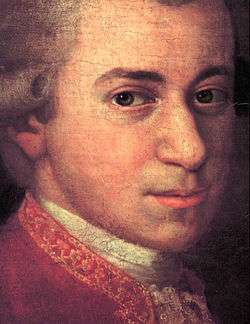Piano Concerto No. 22 (Mozart)

The Piano Concerto No. 22 in E flat major, K. 482, is a concertante work for piano, or pianoforte, and orchestra by Wolfgang Amadeus Mozart. Mozart composed the concerto in December 1785.
This is the first piano concerto of Mozart's to include clarinets in its scoring,[1] and is scored for solo piano, flute, two clarinets (in B-flat), two bassoons, two horns, two trumpets, timpani (in E-flat and B-flat), and strings. It has the following 3 movements:
- Allegro
- Andante
- Allegro
Roger Kamien and Naphtali Wagner have analysed in detail Mozart's use of bridge themes in the exposition of the concerto's first movement.[2] Simon Keefe has analysed the character of the dialogue between the soloist and the orchestra in the concerto's first movement.[3]
The slow second movement in C minor recalls similar slow C minor movements in other Mozart E-flat major concertos such as K. 271 and K. 364. Mozart's father, in a famous letter to Maria ("Nannerl"), expressed surprise that a call was made for the slow movement ("a rather unusual occurrence!") to be repeated.[4]
In the rondo finale, the main theme resembles that of Mozart's third horn concerto (K. 447). Adena Portowitz has noted similar features between the finale of the K. 271 and K. 482 concerti.[5] In another similarity to K. 271, the finale is interrupted by a lengthy and slow minuet episode before returning to the main theme for a lively finish (also recalling Count Almaviva's adagio pleadings for forgiveness leading to a buffa conclusion in Le Nozze di Figaro- a work that Mozart was working on at this time). The Andantino episode of K. 482 is melodically simpler than the parallel episode in K. 271, at least on paper, and less complex in form as well, consisting of two eight-bar phrases played by the orchestra and repeated with the solo, followed by a transition back to the rondo theme. (The Menuetto episode of K. 271, while often described as a set of variations, is actually in a more elaborate rounded binary form with both parts repeated, again followed by a transition back to the main rondo theme.) M. S. Cole has noted that the K. 482's finale marks Mozart's last use of potpourri in his compositions.[6]
References
- ↑ Thomson, Katharine (January 1976). "Mozart and Freemasonry". Music & Letters. 57 (1): 25–46. doi:10.1093/ml/LVII.1.25. JSTOR 733806.
- ↑ Kamien, Roger and Wagner, Naphtali; Wagner, Naphtali (Spring 1997). "Bridge Themes within a Chromaticized Voice Exchange in Mozart Expositions". Music Theory Spectrum. 19 (1): 1–12. doi:10.1525/mts.1997.19.1.02a00010. JSTOR 745996.
- ↑ Keefe, Simon P. (Summer 1999). "Dramatic Dialogue in Mozart's Viennese Piano Concertos: A Study of Competition and Cooperation in Three First Movements". The Musical Quarterly. 83 (2): 169–204. doi:10.1093/mq/83.2.169. Retrieved 2008-03-15.
- ↑ Hutchings (1998, 143)
- ↑ Portowitz, Adena (Winter 2001). "Art and Taste in Mozart's Sonata-Rondo Finales: Two Case Studies". The Journal of Musicology. 18 (1): 129–149. doi:10.1525/jm.2001.18.1.129. ISSN 0277-9269. Retrieved 2008-03-14.
- ↑ Cole, M.S. (1974). "Mozart Rondo Finales with Changes of Meter and Tempo". Studia Musicologica Academiae Scientiarum Hungaricae. T. 16 (Fasc. 1/4): 25–53. doi:10.2307/901841. JSTOR 901841.
Sources
- Hutchings, Arthur, A Companion to Mozart's Piano Concertos, Oxford University Press (original publication, 1948).
- Steinberg, Michael, The Concerto: A Listener's Guide, Oxford (1998, ISBN 0-19-510330-0)
External links
- Konzert in Es KV 482: Score and critical report (German) in the Neue Mozart-Ausgabe
- Piano Concerto No. 22: Scores at the International Music Score Library Project

